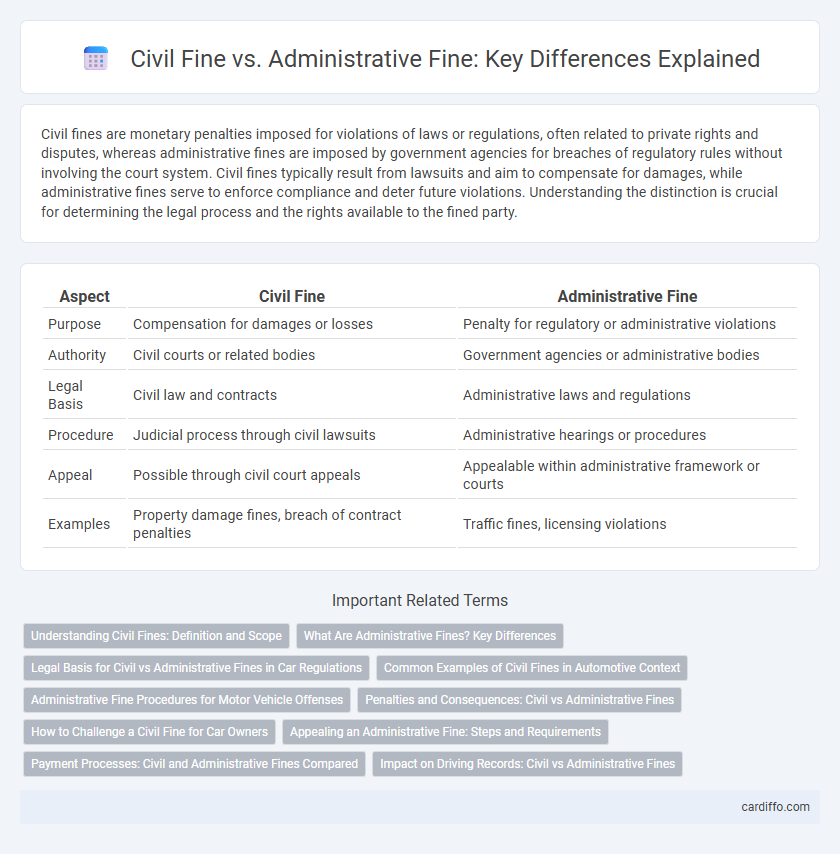Civil fines are monetary penalties imposed for violations of laws or regulations, often related to private rights and disputes, whereas administrative fines are imposed by government agencies for breaches of regulatory rules without involving the court system. Civil fines typically result from lawsuits and aim to compensate for damages, while administrative fines serve to enforce compliance and deter future violations. Understanding the distinction is crucial for determining the legal process and the rights available to the fined party.
Table of Comparison
| Aspect | Civil Fine | Administrative Fine |
|---|---|---|
| Purpose | Compensation for damages or losses | Penalty for regulatory or administrative violations |
| Authority | Civil courts or related bodies | Government agencies or administrative bodies |
| Legal Basis | Civil law and contracts | Administrative laws and regulations |
| Procedure | Judicial process through civil lawsuits | Administrative hearings or procedures |
| Appeal | Possible through civil court appeals | Appealable within administrative framework or courts |
| Examples | Property damage fines, breach of contract penalties | Traffic fines, licensing violations |
Understanding Civil Fines: Definition and Scope
Civil fines are monetary penalties imposed for violations of laws that do not involve criminal charges, typically relating to breaches of regulations or contractual obligations. Their scope covers damages intended to compensate the injured party or enforce compliance, often assessed in cases like traffic violations, environmental infractions, or consumer protection issues. Understanding civil fines requires recognizing their non-criminal nature and the legal frameworks that govern their application and enforcement.
What Are Administrative Fines? Key Differences
Administrative fines are penalties imposed by government agencies for violations of regulations without involving the court system, often related to non-compliance in sectors like environmental law, health, and safety. Civil fines typically arise from court proceedings in civil lawsuits addressing harm or damage caused, with a focus on compensation or deterrence. Key differences include the issuing authority--administrative fines come from regulatory bodies, while civil fines result from judicial decisions--and the procedural context, where administrative fines are part of enforcement actions, and civil fines are tied to litigation outcomes.
Legal Basis for Civil vs Administrative Fines in Car Regulations
Civil fines in car regulations are primarily grounded in statutory laws that define penalties for traffic violations and damages, ensuring compensation and deterrence for wrongful conduct. Administrative fines derive their authority from regulatory agencies empowered by government statutes to enforce specific vehicle codes and standards, targeting compliance with licensing, safety, and environmental rules. Legal frameworks distinctly separate civil liability from administrative enforcement, with civil fines addressing harm compensation and administrative fines emphasizing regulatory adherence.
Common Examples of Civil Fines in Automotive Context
Civil fines in the automotive sector commonly include penalties for parking violations, failure to comply with vehicle emissions standards, and non-payment of tolls. These fines are imposed to enforce traffic laws and environmental regulations, aiming to promote road safety and reduce pollution. Compliance with civil fines is critical to avoid further legal consequences such as license suspension or increased financial penalties.
Administrative Fine Procedures for Motor Vehicle Offenses
Administrative fine procedures for motor vehicle offenses typically involve a streamlined process where violations such as speeding or illegal parking are addressed through citations issued by traffic authorities. These procedures require the offender to pay the fine within a specified timeframe or contest the charge at an administrative hearing, often without the need for formal court involvement. The emphasis on efficiency and prompt resolution helps reduce case backlogs and ensures compliance with traffic regulations.
Penalties and Consequences: Civil vs Administrative Fines
Civil fines typically result from violations of laws enforced by courts and often involve monetary penalties intended to compensate for damages or enforce compliance, impacting credit records and leading to potential liens or wage garnishments. Administrative fines, imposed by government agencies or regulatory bodies, serve as deterrents for rule violations and usually involve swift penalties without the necessity of court proceedings, but repeated infractions can escalate to license suspensions or stricter regulatory actions. Both fines carry significant legal consequences, affecting individuals or businesses differently depending on the nature of the offense and enforcing authority.
How to Challenge a Civil Fine for Car Owners
Car owners seeking to challenge a civil fine must gather evidence such as photos, witness statements, and official documents to support their case. Filing a formal appeal with the relevant traffic or municipal authority within the specified deadline is crucial to ensure the challenge is considered. Understanding local regulations and consulting legal experts can increase the chances of successfully overturning the fine.
Appealing an Administrative Fine: Steps and Requirements
Appealing an administrative fine involves submitting a formal written request to the relevant authority within a specified deadline, typically 30 days from the notification date. The appeal must include clear grounds for contesting the fine, supporting evidence, and adherence to procedural requirements as outlined in local regulations. Failure to meet these conditions may result in the dismissal of the appeal and enforcement of the original administrative fine.
Payment Processes: Civil and Administrative Fines Compared
Payment processes for civil fines typically involve structured deadlines and may include installment options, while administrative fines often require immediate or expedited payment to avoid escalation. Civil fines are processed through judicial systems, with payments made to courts or related governmental agencies. Administrative fines are handled by specific regulatory bodies, enabling more direct and sometimes automated payment methods.
Impact on Driving Records: Civil vs Administrative Fines
Civil fines typically do not appear on driving records and thus have minimal impact on insurance rates or license status. Administrative fines, often issued by DMV or related agencies, directly affect driving records, potentially leading to increased insurance premiums or license suspension. The distinction between these fines is crucial for drivers seeking to maintain a clean driving history and avoid long-term consequences on their record.
Civil fine vs administrative fine Infographic

 cardiffo.com
cardiffo.com